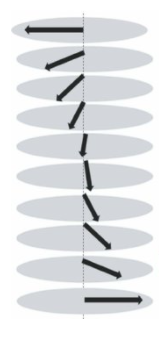Consider a shaft which is fixed at one of the ends and is acted upon by a torque at the free end as shown.
 We take a plane inside the shaft as shown in the figure before the torque is applied. I'm interested in knowing how the plane will look after the torque has been applied.
We take a plane inside the shaft as shown in the figure before the torque is applied. I'm interested in knowing how the plane will look after the torque has been applied.
My intuition tells me that the plane will be bent (for the lack of a better word) after the loading as shown below. (
 However if that is the case, the radial lines will curve at the end of loading and one of the major assumptions that the book I'm referring to for studying torsion in circular shafts, is that the radial lines must remain straight at all times.
However if that is the case, the radial lines will curve at the end of loading and one of the major assumptions that the book I'm referring to for studying torsion in circular shafts, is that the radial lines must remain straight at all times.
Conversely, if the radial lines are to remain straight at all times, that would mean the plane after the loading doesn't bend and remains flat. However, is this possible physically, provided that the two edges (shown in red below) are fixed.





